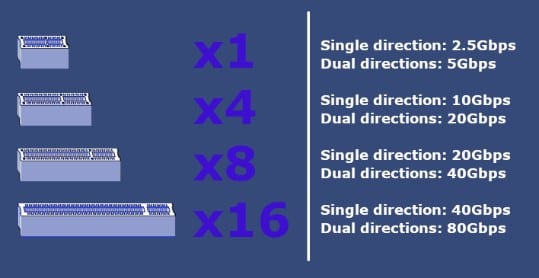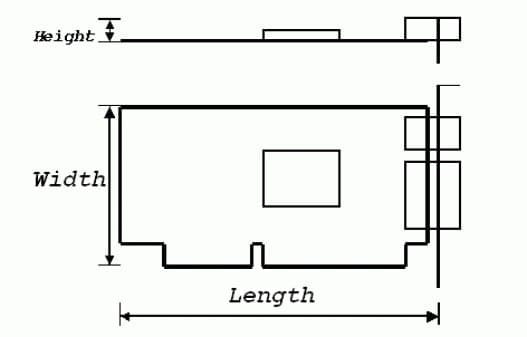PCIe Network Interface Card Guide
In order to get oversight of PCIe NIC cards and answer most common questions, we have prepared this Network Interface Card Guide.
Intro:
PCI (Peripheral Component Interconnect) is a type of computer bus for attaching or inserting peripheral devices into a computer. PCI standard was developed by Intel in 1990 and was widely implemented in computers five years later. Today, the specifications for PCI and its variants are maintained by the PCI-SIG (PCI Special Interest Group), a consortium of industry leading companies.
PCI is a general-purpose connection standard designed to support multiple devices of various kinds, including graphics hardware, audio hardware and network hardware. During years of technological development, revisions of the PCI standard have added new features and performance improvements, including different bus speeds and bus widths.
PCIe (PCI Express) is the more recently introduced standard for connecting devices to computers designed to replace the older PCI, PCI-X and AGP bus standards. It provides software-compatible with PCI but has higher potential bandwidth and greater flexibility than PCI.
PCIe standard has been several times updated in order to improve performance and introduce new features. PCIe 1.0 was initially launched in 2002. To meet the growing demands for higher bandwidth, successive versions have been invented and introduced to the peripheral device manufacturers. At present, there are five different generations of PCIe standards: PCIe 1.0, PCIe 2.0, PCIe 3.0, PCIe 4.0, PCIe 5.0. With PCIe 6.0 generation coming in 2021.
PCI Express card refers to any kind of adapter which is used in motherboard-level connections. Specifically PCIe based expansion cards are connected directly to slots in PCIe compatible motherboard. Expansion cards can be of various kind, network adapters, graphic cards, USB port expansion and many more other type of interfaces.
There are five physical size types of PCIe cards: x1, x4, x8, x16 and x32. These numbers correspond to the transmission line count in the PCIe slot. The larger count of transmission lines, the larger dimensions of card (the last one x32 is not widely used).
PCIe card fits into its physical size or larger slot (x16 largest), but won`t fit in smaller slot, for example x8 card will not fit in x4 slot. The sizes in which PCIe cards are manufactured also varies:
| Full-height bracket | 115.95 mm |
| Low-profile bracket | 79.20 mm |
| Full-length | 312 mm |
| Half-length | 175.26 mm |
Also there is Double and Triple PCIe cards. Those cards fill corresponding PCIe slot count (bracket height) on equipment interface panel.
PCIe generation data transfer rates:
| PCIe version | Line Code | Transfer Rate | Bandwidth | |||
|---|---|---|---|---|---|---|
| x1 | x4 | x8 | x16 | |||
| 1.0 | 8b/10b | 2.5 GT/s | 250 MB/s | 1 GB/s | 2 GB/s | 4 GB/s |
| 2.0 | 8b/10b | 5 GT/s | 500 MB/s | 2 GB/s | 4 GB/s | 8 GB/s |
| 3.0 | 128b/130b | 8 GT/s | 984.6 MB/s | 4 GB/s | 8 GB/s | 16 GB/s |
| 4.0 | 128b/130b | 16 GT/s | 1.969 GB/s | 8 GB/s | 16 GB/s | 32 GB/s |
| 5.0 | 128b/130b | 32 GT/s | 4 GB/s | 16 GB/s | 32 GB/s | 64 GB/s |
| 6.0 | TBA | 64 GT/s | 8 GB/s | 32 GB/s | 64 GB/s | 128 GB/s |
EDGEOPTIC.com offers PCI and PCIe slot compatible Network Interface Cards (NIC). NIC is just one type of card which can be used in PCIe slot (there are many different PCIe slot compatible products in the world). NIC is the subsystem responsible for connecting an end node to the network. An end node may be a computer system or a network storage device. More specifically, these network devices support platforms such as PCs, workstations, laptops, servers, and storage arrays. NIC provides network access to these devices. NIC subsystem also includes driver software running on the host OS. The driver implements the software to control the behavior of the NIC for functions such as send and receive.
PCIe x4 network interface card four lane diagram
How to correctly choose NIC?
If this is your first encounter with network cards, then it is possible that some parts seems confusing and needs a bit of explanation. First part of This Network Interface Card Guide introduces EDGEOPTIC offered network interface cards and their specifications. Second part focuses more on their usage scenarios. We hope this information will answer most of your questions.
| SKU | Category | Controller | System interface | Ports |
|---|---|---|---|---|
| 100G-NIC-E810-2O | Dual Port 100G QSFP28 PCIe | Intel® E810-CAM2 | PCIe v3.0 x8 (8GT/s) | 2x40G QSFP+ |
| 40G-NIC-XL710-2O | Dual Port 40G QSFP+ PCIe | Intel® XL710 | PCIe v3.0 x8 (8GT/s) | 2x10G QSFP28 |
| 40G-NIC-XL710-1O | Single Port 40G QSFP+ PCIe | Intel® XL710 | PCIe v3.0 x8 (8GT/s) | 1x40G QSFP+ |
| 25G-NIC-XXV710-2O | Dual Port 25G SFP28 PCIe | Intel® XXV710 | PCIe v3.0 x8 (8GT/s) | 2x25G SFP28 |
| 10G-NIC-X710-2O | Dual Port 10G SFP+ PCIe | Intel® X710 | PCIe v3.0 x8 (8GT/s) | 2x10G SFP+ |
| 10G-NIC-82599ES-2O | Dual Port 10G SFP+ PCIe | Intel® 82599ES | PCIe v2.0 x8(5GT/s or 2.5GT/s) | 2x10G SFP+ |
| 10G-NIC-XL710-4O | Quad Port 10G SFP+ PCIe | Intel® XL710 | PCIe v3.0 x8 (8GT/s) | 4x10G SFP+ |
| 10G-NIC-82599EN-1O | Single Port 10G SFP+ PCIe | Intel® 82599EN | PCIe v2.0 x8(5GT/s or 2.5GT/s) | 1x10G SFP+ |
| 10G-NIC-X540-2T | Dual Port 10G Copper RJ-45 PCIe | Intel® X540 | PCIe v2.1 x8(5GT/s or 2.5GT/s) | 2x10G RJ-45 |
| 10G-NIC-XL710-4T | Dual Port 10G Copper RJ-45 PCIe | Intel® XL710 | PCIe v2.1 x8(5GT/s or 2.5GT/s) | 2x10G RJ-45 |
| 10G-NIC-X550-1T | Single Port 10G Copper RJ-45 PCIe | Intel® X550 | PCIe v3.0 x4 (8.0GT/s) | 1x10G RJ-45 |
| 10G-NIC-X550-2T | Dual Port 10G Copper RJ-45 PCIe | Intel® X550 | PCIe v3.0 x4 (8.0GT/s) | 2x10G RJ-45 |
| 10G-NIC-X540-1T | Single Port 10G Copper RJ-45 PCIe | Intel® X540 | PCIe v2.1 x8(5GT/s or 2.5GT/s) | 1x10G RJ-45 |
| 1G-NIC-I350-4O | Quad Port 1G SFP PCIe | Intel® I350 | PCIe v2.1 x4 (5GT/s or 2.5GT/s) | 4x1G SFP |
| 1G-NIC-I350-2O | Dual Port 1G SFP PCIe | Intel® I350 | PCIe v2.1 x4 (5GT/s or 2.5GT/s) | 2x1G SFP |
| 1G-NIC-I350-4T | Quad Port 1G Copper RJ-45 PCIe | Intel® I350 | PCIe v2.1 x4(5GT/s or 2.5GT/s) | 4x1G RJ-45 |
| 1G-NIC-82576-2T | Dual Port 1G Copper RJ-45 PCIe | Intel® 82576 | PCIe v2.0 x4 (2.5GT/s) | 2x1G RJ-45 |
| 1G-NIC-I350-2T | Dual Port 1G Copper RJ-45 PCIe | Intel® I350 | PCIe v2.1 x4 (5GT/s or 2.5GT/s) | 2x1G RJ-45 |
| 1G-NIC-82574-1T | Single Port 1G Copper RJ-45 PCIe | Intel® 82574 | PCIe v2.0 x1 (2.5GT/s) | 1x1G RJ-45 |
| 1G-NIC-I210-1T | Single Port 1G Copper RJ-45 PCIe | Intel® I210 | PCIe v2.1 x1 (2.5GT/s) | 1x1G RJ-45 |
Table 1: EDGEOPTIC NIC models:
EDGEOPTIC offers various network cards which foremost differs in port count and port speed options. Single port, dual port and quad port options are available with different speeds 40G, 10G, 1G.
Port interface medium type differs per optical transceiver form factor, for example 40G QSFP+ optical transceiver or 10G SFP+ transceiver compatible NIC, as well 10G RJ45 connection for twisted pair cable is an option for connecting to NIC. Port count and speed summary can be seen at the table 1.
Chipset (controller) is the next factor which can differ from one card type to other. Before NIC installation you have to be sure what kind of chipset peripheral devices supports your equipment. Currently EDGEOPTIC offers only Intel® chipset compatible network cards. Specifically which chipsets our network cards supports you can also see in summary table 1.
System mainboard interface type has to be taken into account to ensure network card compatibility with equipment. This means that equipment mainboard should support the planned network card. If the card is PCIe, then mainboard connector also has to be PCIe. Interface types should match, but physical sizes (x1, x4, x8, and x16) can be mixed with one note, that the mainboard slot size should be larger or match network card size. This means in x8 mainboard slot, you can fit any x4 or x1 network card, but not the x16 card.
PCIe version determines the data throughput. The larger version number, the bigger data throughput possible (note: mainboard slot supported PCIe version will determine biggest throughput). PCIe version number also can be seen in summary table 1, at the system interface column.
Next factor is to know what kind of speed you expect for this NIC to handle. Basing on your network requirements you should choose 1G, 10G or 40G capable network card. As well multiport network card can ensure link redundancy.
Important factor when choosing NIC is to understand your network and to know actual place where newly bought NIC will be installed. This includes to be sure of equipment mainboard support for this NIC, necessary traffic type and bandwidth. Equipment motherboard usually support specific type of controller (chipset) network cards. Most popular ones are Intel, Marvell, Mellanox, Qlogic and Broadcom. Functions which you will need from this NIC is another factor for consideration. NIC`s come with many different communication standards, for example: FCoE, iSCSI, PCI-SIG, NFS. Choosing which communication standards has to be supported by network card largely depends on your current network architecture.




